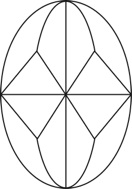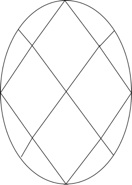Maple Leaves


In the autumn of 2008 I was inspired to try and design a fall egg. I thought it would be interesting to try and create a pysanka version of a lystovka, placing simple leaf motifs onto an egg.
While leaf motifs figure prominently in many pysanka designs, the leaves are generally stylized and sometimes barely recognizable as such. I wanted to make something much more realistic, that would capture the colors of a midwestern fall. In Michigan we have many trees that produce gorgeously colored leaves in the fall–oaks, maples, ashes, beeches, sumac, locusts and others. The most gorgeous of all are the maples, with their bright yellows, oranges, pinks and reds (often all on the same leaf!).
Red maple leaves seemed best bet for a pysanka, so I tried several arrangements of the leaves on a brown eggshell. While the eggs with a random placement were nice, placing the leaves often left odd gaps or strangely shaped leaves. They were also a bit more difficult to reproduce, so I only made two of them. They are the first two eggs pictured below; the second one had black dye issues, and so has a mottled finish.
It is always easier to create an egg with a regular pattern; I divided the egg with a “Triangle” division:

and placed a leaf in each triangle,, with the stems coming together at the center of each eighth division. You find similar motifs in many triangle division eggs. I then did several variations, varying the width of the stylus (fine or medium) and the color red used (UGS scarlet and UGS red). You can see the variations below. The scarlet dyes produced very orangey eggs–pretty, but not the effect I was looking for. The red had to be monitored very carefully, as it can dye an egg very dark red if left in too long. If I were to make these eggs again, I would use a scarlet/red blend* to get the perfect red.
In 2009 I tried a slightly different arrangement of leaves. I wanted to make them look more natural than the triangle arrangement, but still regular enough that it would be easy to reproduce. I first tried using the “12 Diamond” division:

I placed a leaf in each diamond, but the leaves in the top and bottom rows ended up being much smaller than those in the middle row. I then decided to draw a Triangle division, as above, but then eliminate all the horizontal and perpendicular lines, giving me a variation of the 12 diamond.
In the top and bottom rows I placed leaves, all with the same orientation. In both rows, the top of each leaf was at the point (top or bottom) of the egg. In the middle row the leaves alternated in orientation, up and down. In any case, it worked beautifully, giving me the 2009 leaves below.
In 2010, looking for a new and different way to arrange maple leaves, I decided to try something with a diagonal division. I had been studying Bukovynian pysanky, and this is a very popular division in that region. I experimented with diagonals, first making a pysanka with a diagonal band and a solar motif (not pictured yet), and then trying to use to intersecting bands. The latter proved a more aesthetically pleasing arrangement, and it is the one my friends and family got for gifts at Thanksgiving. I alternated the orientation of the leaves in the bands, and came out with two variations; can you spot the differences?
In 2011 I took an entirely new direction, making pysanky-travlenky. I wrote a maple leaf design on pysanky (asymmetric), and filled in the spaces with small ash-type leaves. The maples leaves, as always, were waxed in red, and the ash leaves brown. I then etched the eggs, giving a white final color and a relief effect.
_________
-
*Vira Manko told me that she–and many Ukrainian pysanka artists–mix together a packet each of UGS red and scarlet to get just the right shade of red for traditional patterns.
Maple Leaf Eggs





